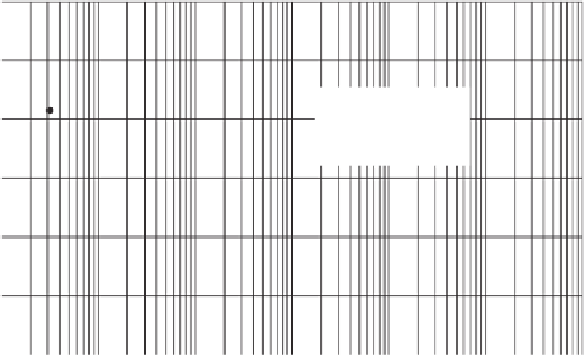Environmental Engineering Reference
In-Depth Information
120
Note: Numbers on curves refer to
preconsolidation pressure
100
6.2 kPa
Total suction
Matric suction
Matric suction
Osmotic suction
80
Matric suction
60
400 kPa
40
Total suction
20
Osmotic suction
0
10
6
1
10
100
1000
10,000
100,000
Total suction, kPa
Figure 5.12
Components of soil suction and total suction for Regina clay (from Fredlund,
2002a).
100
80
Preconsolidation
pressure = 6.2 kPa
60
40
Preconsolidation
pressure = 400 kPa
20
0
10
6
1
10
100
1000
10,000
100,000
Soil suction, kPa
Figure 5.13
Degree of saturation versus soil suction for a highly plastic clay prepared as a
slurry (from Fredlund, 1964).
residual zone. These zones are delineated by two distinct
points along the SWCC: the AEV of the soil and residual
conditions. Unsaturated soil behavior can likewise be
subdivided into three zones. The “boundary effect zone” up
to the air-entry value can be simulated using saturated soil
mechanics principles. The “transition zone” between the
air-entry value and residual conditions requires the usage of
the theories of unsaturated soil mechanics. The unsaturated
soil properties in the transition zone become nonlinear,
and as a result, subsequent mathematical formulations are
nonlinear. There are also differences in soil behavior that
occur once the “residual zone” is entered.
Unsaturated soil theories have mainly been proposed and
tested for uniqueness for seepage, shear strength, and volume
change in each of the degree of saturation zones. The perme-
ability function for a soil can be used to illustrate differences
in behavior as a soil desaturates. At soil suctions below the
air-entry value, water flows through the soil in response to the
soil property called the saturated coefficient of permeability.
Between the air-entry value and residual conditions, the coef-
ficient of permeability decreases in essentially a linear manner
on a plot of the logarithm of soil suction versus the logarithm
of coefficient of permeability. There is little information and
fewmeasurements regarding liquid water flow at soil suctions
beyond residual conditions. However, the general consensus
appears to be that liquid flow essentially ceases and vapor
flow begins to dominate moisture flow once residual suction
is exceeded.
Van Genuchten (1980) suggested that residual conditions
correspond to soil suctions beyond 1500 kPa. A residual suc-
tion of 1500 kPa does not reflect a distinct break in every
SWCC but it does separate laboratory measurements of suc-
tion made using pressure plate apparatuses from those made
using vapor pressure equalization. An arbitrary construc-
tion procedure can be used for defining the residual point
on the SWCC (Fredlund, 1997a; Vanapalli et al., 1998). The














































Search WWH ::

Custom Search